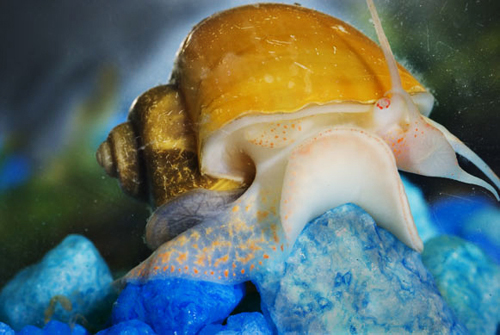
How to Photograph Aquatic Snails
by Christa McChancy
 |
Photo by Christa McChancy |
The spike-topped apple snail, Pomacea bridgessii, is a common addition to almost any freshwater fish tanks. Originating from South America, mainly the Amazon River system, there are many varieties of apple snails. Also known as mystery or Inca snails, these snails come in a variety of colors. Preferring to remain submerged, apple snails are equipped with gills that allow them to remain underwater for the majority of their life. These snails will come up to the water surface and breathe air through their tubular siphon but the siphon is not their primary way of breathing; the siphon is used when there are low oxygen levels in the water.
Caring for your snails
The spike-topped apple snail, Pomacea bridgessii, is an algae eater but when their environment lacks algae they will eat soft vegetation. Fish flakes, rotting plants or algae wafers are recommended food sources. The shell of the apple snail is made up of calcium, which the snail must obtain from the water. If the water is deficient in calcium the shell will start to form holes; to prevent this from happening it is recommended that liquid calcium be added to your tank. Clean water is not as important for a snail but is recommended if you donít want your tank to smell. When changing the water of your tank, be sure not to use tap water that contains copper or other metals as the apple snail is very sensitive. Tank size is also important; it is recommended that you allot 2.5 gallons per snail. Keeping the tank covered is very important, if there is no cover or large opening in the cover then the snails can leave the tank. Apple snails can be purchased at most pet stores that carry fish or a pond supply stores.
So how does one photograph a creature that rarely comes out of the water?
 |
Photo by Heather Meers |
What you will need to photograph aquatic snails:
In attempting to photograph my apple snails, I ran into a few problems. First off, the tank I purchased to house my tiny friends is made of plastic; not the ideal media to photograph through. Being short on funds, I couldn't buy a glass tank nor could I make a large water cell. I tried several different glass containers but most glass is blown with a thickness change throughout. Thickness changes cause distortion, making it difficult to get good focus. So I decided to just use the tank I already had. I have included two examples of what can go wrong when you are photographing through plastic with scratches and curved corners. My setup, pictured above, included two small tungsten lights angled down through the water (a polarizer could be used to reduce reflections). To get the most photographs, shoot late in the day as apple snails are the most active during that time. Although snails appear to be slow moving creatures, a hand-held flash unit is needed to freeze motion (when placed under lights, a snailís pace is quite fast). I recommend taking lots of images with different exposures but be sure to diffuse your flash (I used the built-in diffuser on my flash) and hold the flash off at an angle from above. Doing so will reduce the amount of glare off the surface of the tank and can improve your overall image quality. If you hold the flash off at an angle you can almost make the surface of the tank disappear, reducing the amount of work you need to do in Photoshop.
 |
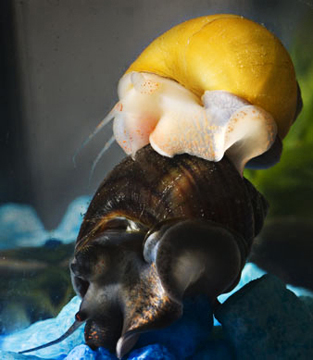 |
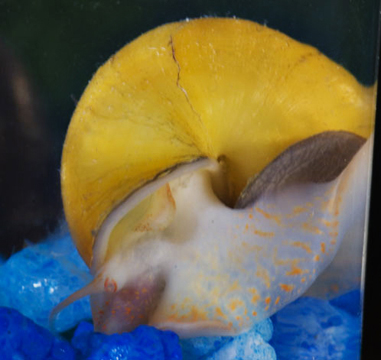 |
Golden snail beginning to climb the tank wall |
Piggy backing - Golden snail feasting on algae from shell of black snail |
Golden snail returning to tank bottom |
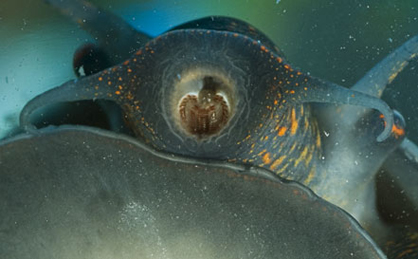 |
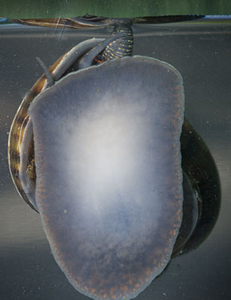 |
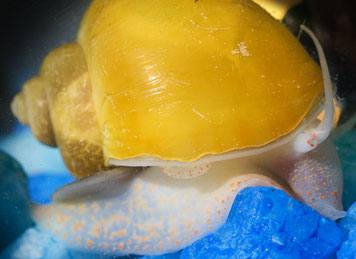 |
Close-up of mouth - the radula
|
Black snail using its siphon to breath in oxygen depleted water. |
Golden apple snail |
What to try to avoid when shooting
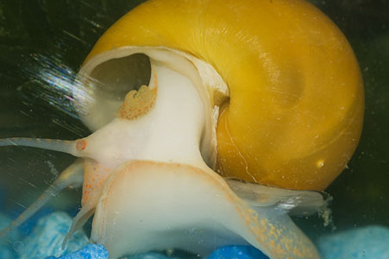 |
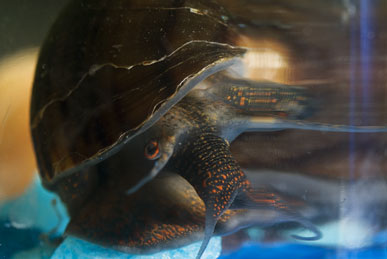 |
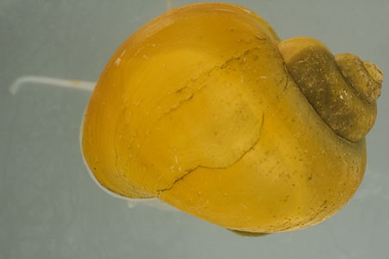 |
Plastic tanks tend to have lots of scratches and stress marks. |
Shooting through curved surfaces causes distortions that even Photoshop can't fix. |
Using a small water cell gives you very little room to work and very few angles of view. This water cell was only 2 inches deep so the snail only crawled at the bottom. |
A good web site for more information on apple snails
Questions or comments please feel free to contact me
I am a fourth year student at Rochester Institute of Technology, Rochester, NY, USA. I am majoring in Biomedical Photographic Communications with a concentration in Ophthalmic photography. ©Christa McChancy 2006
Special thanks to Heather Meers, Jason Sober and Michael Hakans for their help with this site.
Return to
index of articles
by students on the 'Principles and techniques of photomacrography'
course, November 2006,
Biomedical Photographic Communications (BPC)
program at the Rochester Institute of Technology (RIT).
Article hosted on Micscape
Magazine (Microscopy-UK).